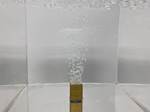Sintered, Porous Mold Steel Eliminates Gas Buildup
Molder’s World highlights its acclaimed Vortex self-venting mold steel, which uses a system of microscopic, interconnected pores to optimize molding processes.
Molder’s World Inc. draws attention to Vortex, a self-venting mold steel that it says is quickly becoming the industry standard. Specializing in self-venting mold steels since inception in 2001, Molder’s World is most well known as the preeminent distributor of Porcerax II prior to its discontinuation. Vortex, as its replacement, is claimed to be the most exciting development in the company’s 20+ year history.
Vortex uses a system of microscopic, interconnected pores with an average diameter of 7 µm (0.0003") interspersed throughout the steel. As pressure builds inside the mold, the gases present are forced directly through the Vortex, eliminating gas buildup, reducing injection pressure, lowering cycle times and gloss levels, and substantially reducing scrap and reject rates, enabling molders to save money in the process.
When compared to Porcerax II, Vortex is roughly 15% harder (43 HRC average), stronger (TR: 834 MPa) and less expensive than Porcerax II was prior to its discontinuation.
Though tool shops and molders may primarily identify Vortex for its use in speaker grill insert, interior automotive and medical applications, Vortex can be used in nearly every molding application where gas buildup is problematic. A variety of square, rectangle and round sizes, as well as self-venting core pins and plugs, are available.
Vortex is produced in the U.S. and is globally used in automotive, medical and commercial injection molding applications as well as lost-core wax molds.
Related Content
-
It Starts With the Part: A Plastic Part Checklist Ensures Good Mold Design
All successful mold build projects start with examining the part to be molded to ensure it is moldable and will meet the customers' production objectives.
-
Solving Mold Alignment Problems with the Right Alignment Lock
Correct alignment lock selection can reduce maintenance costs and molding downtime, as well as increase part quality over the mold’s entire life.
-
The Ins and Outs of Hot Runner Temperature Control
A training checklist that explains the why and how of proper hot runner temperature control and system management.















